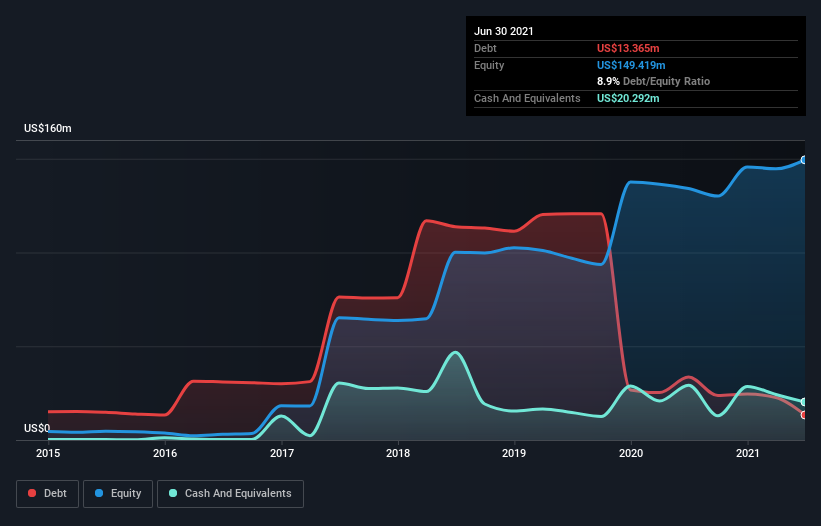Is Asure Software (NASDAQ:ASUR) Using Debt Sensibly?
Warren Buffett famously said, 'Volatility is far from synonymous with risk.' So it seems the smart money knows that debt - which is usually involved in bankruptcies - is a very important factor, when you assess how risky a company is. Importantly, Asure Software, Inc. (NASDAQ:ASUR) does carry debt. But the real question is whether this debt is making the company risky.
When Is Debt A Problem?
Debt is a tool to help businesses grow, but if a business is incapable of paying off its lenders, then it exists at their mercy. In the worst case scenario, a company can go bankrupt if it cannot pay its creditors. However, a more frequent (but still costly) occurrence is where a company must issue shares at bargain-basement prices, permanently diluting shareholders, just to shore up its balance sheet. Of course, the upside of debt is that it often represents cheap capital, especially when it replaces dilution in a company with the ability to reinvest at high rates of return. The first step when considering a company's debt levels is to consider its cash and debt together.
See our latest analysis for Asure Software
What Is Asure Software's Debt?
You can click the graphic below for the historical numbers, but it shows that Asure Software had US$13.4m of debt in June 2021, down from US$33.6m, one year before. However, it does have US$20.3m in cash offsetting this, leading to net cash of US$6.93m.
How Strong Is Asure Software's Balance Sheet?
We can see from the most recent balance sheet that Asure Software had liabilities of US$219.9m falling due within a year, and liabilities of US$16.4m due beyond that. On the other hand, it had cash of US$20.3m and US$3.48m worth of receivables due within a year. So its liabilities outweigh the sum of its cash and (near-term) receivables by US$212.4m.
When you consider that this deficiency exceeds the company's US$183.4m market capitalization, you might well be inclined to review the balance sheet intently. In the scenario where the company had to clean up its balance sheet quickly, it seems likely shareholders would suffer extensive dilution. Asure Software boasts net cash, so it's fair to say it does not have a heavy debt load, even if it does have very significant liabilities, in total. When analysing debt levels, the balance sheet is the obvious place to start. But ultimately the future profitability of the business will decide if Asure Software can strengthen its balance sheet over time. So if you want to see what the professionals think, you might find this free report on analyst profit forecasts to be interesting.
Over 12 months, Asure Software saw its revenue hold pretty steady, and it did not report positive earnings before interest and tax. While that hardly impresses, its not too bad either.
So How Risky Is Asure Software?
By their very nature companies that are losing money are more risky than those with a long history of profitability. And we do note that Asure Software had an earnings before interest and tax (EBIT) loss, over the last year. And over the same period it saw negative free cash outflow of US$5.6m and booked a US$8.4m accounting loss. But at least it has US$6.93m on the balance sheet to spend on growth, near-term. Overall, we'd say the stock is a bit risky, and we're usually very cautious until we see positive free cash flow. There's no doubt that we learn most about debt from the balance sheet. However, not all investment risk resides within the balance sheet - far from it. To that end, you should learn about the 3 warning signs we've spotted with Asure Software (including 1 which is potentially serious) .
If you're interested in investing in businesses that can grow profits without the burden of debt, then check out this free list of growing businesses that have net cash on the balance sheet.
This article by Simply Wall St is general in nature. We provide commentary based on historical data and analyst forecasts only using an unbiased methodology and our articles are not intended to be financial advice. It does not constitute a recommendation to buy or sell any stock, and does not take account of your objectives, or your financial situation. We aim to bring you long-term focused analysis driven by fundamental data. Note that our analysis may not factor in the latest price-sensitive company announcements or qualitative material. Simply Wall St has no position in any stocks mentioned.
Have feedback on this article? Concerned about the content? Get in touch with us directly. Alternatively, email editorial-team (at) simplywallst.com.

 Yahoo Finance
Yahoo Finance 